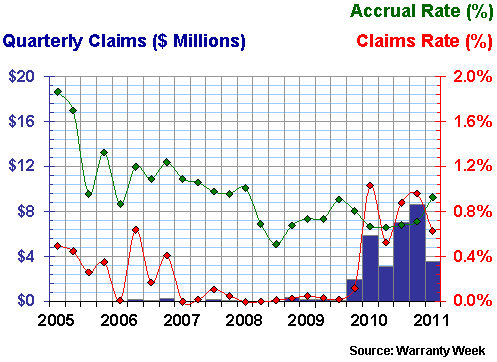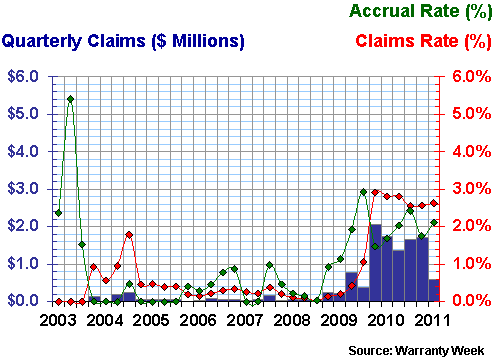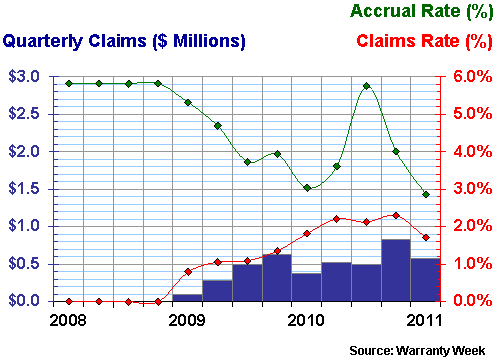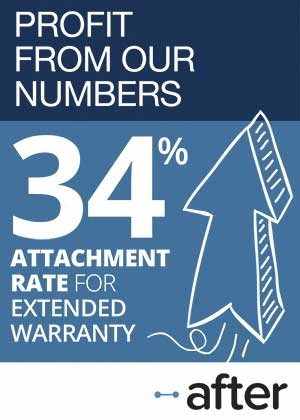Power Equipment Warranty Report: While GE dominates the traditional end of the electrical power generation business, a whole group of new companies are jumping into the solar energy and electric car businesses. And some retailers that never had much to do with the gasoline engine are angling to become the new homes of the charging stations.
Green is the color of alternative technologies such as solar energy and electric cars. And green is also a descriptive term for many of the very young companies in the industry, where five-year-old startups think nothing of writing 25-year warranties.
The question is, will any of these new companies or new technologies last long enough to see their warranties expire naturally? And until they do, how should they budget for the inevitable warranty expenses that will arise along the way?
There was once a time when electrical appliances were the latest new thing for the home, and when the horseless carriage, the gasoline it burned and the repairs it needed required the creation of entirely new retail networks. Today, we take it for granted that there are electrical power plants and wiring networks and gasoline distribution networks and automobile repair outlets all over the place.
The Green Revolution
Now, those networks are about to change again. But before they do, the traditional power generating equipment manufacturers will still have a few warranty claims to pay.
We count some of the electrical equipment warranty expenses in categories such as building materials or appliances. Some of the generator and turbine manufacturers, such as Honda, Cummins and Caterpillar, fall more comfortably into the automotive category because of the nature of the rest of their product lines. But that still leaves the handful of companies that make nothing but turbines, generators, power supplies, batteries, and chargers. And that's who we're profiling this week, along with all the solar energy, windmill, rechargeable battery and other alternative energy equipment makers.
For the sake of saving space, we won't repeat the chart detailing the annual claims payments of the power generation equipment manufacturers that was included in Figure 10 of the April 1 newsletter. But that chart listed the industry segment's claims total at $740 million, down 10% from 2009's $824 million claims total.
In Figure 1, however, we are enumerating the total accruals set aside each calendar year since 2003 by the 21 companies that we're tracking within the power generation equipment manufacturer segment. Note that accruals were down 21% in 2010, and that this was the second large annual decrease in a row after a massive increase took place in 2007-2008.
Figure 1
Power Equipment Warranties
Accruals Made by U.S.-based Companies
(in US$ millions, 2003-2010)
The same thing happened with claims. Power generation equipment manufacturers saw a 58% jump in claims payments in 2007-2008, from $600 million to $951 million. And we think the reason behind both of these increases and the subsequent decreases has the same explanation: General Electric Co.
The giant company, a major manufacturer of the turbines used in traditional oil- or coal-burning power plants as well as the windmills and nuclear reactors used for alternative energy production, is by far the dominant player in this industry segment. For instance, of the $951 million in claims and $1.088 billion in accruals tallied in 2008, GE accounted for 96% of the claims and 95% of the entire industry's accruals.
In other words, looking at the power generation equipment manufacturer segment is a bit like looking at GE. In Figure 2, we've assembled the year-end warranty reserve fund balances of the segment's members, and depending on the year in question, 94% to 96% of the reserves are GE's.
Figure 2
Power Equipment Warranties
Reserves Held by U.S.-based Companies
(in US$ millions, 2003-2010)
So let's not look at GE. Let's instead turn our attention to the smaller companies in the industry, specifically those engaged in the manufacture of solar energy equipment, electric cars, and the charging equipment needed for electric vehicles.
Young Companies with Long Warranties
There are two problems. First, very few of these companies have an eight-year track record with warranty expenses, so most of these charts will not go back to 2003, the year that most other warranty providers first began including their claims and accrual totals in their annual reports.
Second, these companies typically make products with very long warranties that have very low warranty costs when they're very new. So the gap between their claims and accrual rates is typically very large at the outset, and indeed the accuracy of their future cost predictions is difficult to verify.
How do you accrue in 2010 for warranties that don't completely expire until 2045? Or more realistically, how do you predict the 25-year claims emergence pattern of a product line that's not even a decade old yet? It can be done, but it's going to have to involve quite a bit of guesswork and some constant adjustments.
For instance, let's look at First Solar Inc., a company which began shipping product in 2002, and began trading its stock on the NASDAQ exchange in 2006.
In Figure 3 we've included just the years 2005 to 2011. There's actually warranty data going back to 2004, but in that year the company established its warranty reserve fund with an initial $1.9 million accrual. That's admirable of the company, but with only $13.5 million in sales that year, it's also a 14% accrual rate.
We don't want the chart to start out that way, so we omitted the 2004 data. Instead, we begin 2005 with a more reasonable 1.9% accrual rate, which is an 0.9% accrual rate by the beginning of 2006 and a 1.1% rate by the start of 2007.
Figure 3
First Solar Inc.
Warranty Claims & Accrual Rates, 2005-2011
(as a percentage of product revenue)
At this scale, it's easier for the data to support the point we want to make: back in the early years, First Solar was just guessing that warranty claims would cost it around one percent of sales. And guess what? That estimate turned out to be right!
More specifically, from 2005 to the middle of 2009 there weren't many claims. But the equipment was still young. By late 2009, claims payments began to climb from near zero, as the equipment in the field began to age. But the claims rate never rose above 1.1% -- at least not yet.
Guessing Correctly
In the last five quarters, in fact (covering the period from December 26, 2009 to March 31, 2011), First Solar's claims and accrual rates have remained very close to each other. In other words, the company's actual claims costs have turned out to be close to what it predicted they would be four or five years ago.
That's not easy to get right with new technologies. And it's even harder to do with new technologies that are typically exposed to the elements year round and are typically warranted for periods of 10 to 25 years. Last month, in fact, the CFV Solar Test Laboratory began offering its services to solar panel manufacturers, helping them to sharpen their guesses regarding product longevity, reliability, and performance metrics.
And yes, it really is guesswork. One solar panel manufacturer, in fact, admitted in its annual report that its accruals were determined partly by looking at what competitors were doing, and partly by looking at its own field data, and then guessing whether they were a little too high or a little too low. What auditor would sign off on that kind of methodology? But what's the alternative?
A Chinese solar manufacturer named JinkoSolar may actually have found such an alternative. If a new company can't be sure it will have enough funds to pay all claims in the distant future, and indeed if it can't even guarantee it will still be in business in 15, 20 or 25 years, at least it can buy a non-cancellable insurance policy for its product warranties. And that's what JinkoSolar has done: it secured a contractual liability insurance policy with PowerGuard Specialty Insurance Services.
Another Lucky Guess
In Figure 4, we're spotlighting another company that seemed to make its best guess with accruals for a couple of years, before actual claims costs gave it a much more accurate range to work with. SunPower Corp., which began reporting warranty accruals in 2004, didn't begin to see substantial warranty claims until 2006.
Its accrual rates in 2004-2005 (omitted from Figure 4) were as high as 4.6% and as low as 0.5%. And just like in the ""Three Little Bears" children's story, those estimates turned out to be too high and too low.
Figure 4
SunPower Corp.
Warranty Claims & Accrual Rates, 2006-2011
(as a percentage of product revenue)
In this case, "just right" turns out to be closer to 1.5%. Or perhaps not? SunPower's claims rate has never gone above one percent. But there are only 18 quarters of substantial data to check it against, so perhaps a 1.5% accrual rate provides a prudent margin of error for the future?
We're not going to present the data for other competitors such as Canadian Solar Inc., Evergreen Solar Inc., Entech Solar Inc., or Westinghouse Solar Inc. (formerly Akeena Solar Inc.). Those who think it's unfair to pick on First Solar and SunPower for their guesswork should look at the charts for those four companies. It almost seems like random data.
With First Solar and SunPower, their early guesses were proven right over time. With the other four, it seems like they're still guessing. And they're so young they don't have much claims data to verify their guesswork. But that hasn't stopped them from writing 25-year warranties!
Industry Veteran
We will, however, present warranty data for a component supplier and technology licensor called Energy Conversion Devices Inc., which is a veteran supplier to both rooftop photovoltaic system manufacturers and electric vehicle makers.
The company is the only one of the six we've selected that has warranty data going back to 2003. But even in Figure 5 below one can see how there was a bit of guesswork involved in arriving at the most appropriate accrual rate for the given product lines.
Figure 5
Energy Conversion Devices Inc.
Warranty Claims & Accrual Rates, 2008-2010
(as a percentage of product revenue)
The company reported no warranty claims during the first three quarters of 2003. But it still found reason to set aside $1.2 million in warranty accruals in fiscal 2003, thus causing that 5.4% spike in the accrual rate. For years it kept its accrual rate below one percent, before pushing it up to two and then three percent as actual claims began to be paid. In fact, for the past 18 months the company has been paying out 2.5% to 3.0% of product revenue to satisfy warranty claims.
Electric Vehicle Chargers
Next, let's look at a pair of companies building the commercial and residential charger systems for plug-in electric vehicles. These are the systems that will be used by owners of the Chevrolet Volt, the Nissan Leaf, and other electrical vehicles, when they deplete the electrical charge stored in their batteries.
In a way, these systems will be like the gasoline pumps of the 21st century, installed at major retail locations all over the world. But besides those commercial systems that sell electrical "fill-ups" to the public, many electric car owners will also likely want to install their own charging system at home, connecting it to the local electrical utility's grid.
AeroVironment Inc. and ECOtality Inc. are two of the companies building the equipment being installed by both the commercial and the residential customers. And they in turn are signing up some surprising clients.
AeroVironment and electrical utilities NRG Energy and TXU Energy are building a network of charging stations in the Houston and Dallas areas, including along major freeways, in key shopping and business districts, at popular retailers and in multi-family community and workplace parking areas. AeroVironment also has the support of both Nissan North America and the BMW Group, which have launched or will soon launch electric vehicle product lines.
ECOtality is working with retailers such as Sears Holdings, Fred Meyer Stores, Macy's, and even the Cracker Barrel Old Country Store chain of restaurants. The operative theory is that customers will drive into the parking lot, plug in their vehicle, and go shopping or have a meal while they wait.
Both companies, however, are working on "quick charge" technology that will cut the refueling down from hours to possibly minutes. And both companies are working with an assortment of local, state and federal government agencies to create charging centers on public land, alongside major highways, in city centers, and anywhere else an electric vehicle is likely to need fuel.
Aerospace or Solar?
It's still early days, though, as is also the case with the solar companies. In fact, we'd suggest that most of the warranty expenses in AeroVironment's chart below comes not from these charging stations, but from the company's other major product line: the Raven, Puma and Wasp unmanned aircraft used on the battlefield and along the border by the U.S. Department of Defense.
Figure 6
AeroVironment Inc.
Warranty Claims & Accrual Rates, 2005-2011
(as a percentage of product revenue)
AeroVironment began reporting its warranty expenses on a quarterly basis in the quarter that ended on July 29, 2006. And they also provided annual data for the year ended April 30, 2006, which is why there are two 2005 quarters without data in Figure 5.
ECOtality is even younger. The company has so far published only three annual reports that contained any warranty data. We took that annual data and chopped it into 12 quarters, as can be seen in Figure 6.
Figure 7
ECOtality Inc.
Warranty Claims & Accrual Rates, 2008-2010
(as a percentage of product revenue)
The problem is, the market is still so young that there's not yet enough volume usage to allow the companies to figure out the warranty cost of their charging stations. When there are thousands of stations being used by hundreds of thousands of customers, we'll be able to figure out whether 0.7% or 3.2% is closer to the long-term average claims rate for this equipment.
Electric Car Batteries
It's the same problem facing the vehicle makers, and particularly the battery makers. For while we have a good idea about the likely warranty profile of the wheels and brakes, we know little about the long-term frequency and severity of repairs on the electric car drivetrain. The warranties on the batteries may be eight or even ten years. But will they last that long? Or will they need to be replaced once or twice while under warranty?
This uncertainty, in fact, may have created a huge new opening for vehicle service contracts. Imagine for a second if the vehicle, the charging station at home, and the charges on the road were all covered by a service contract of some kind. All repairs and replacements are free. Upgrades to faster, better batteries or chargers are free. Just pay the monthly or annual fee and all the worries are gone.
Best of all, some of the retailers selling or operating the charging stations already sell extended warranties for their appliances and electronics, as do most of the vehicle makers. In the old world, the dealers sold the vehicle service contracts and the gasoline retailers provided the fuel and repairs. In the new world, Best Buy or Macy's may have spare batteries to swap if a customer doesn't have time for a full recharge.
There are, of course, many gasoline retailers that also sell candy, cola and cigarettes. And some not only have snacks but also service bays for repairs. But what we're talking about here is the possibility that companies with little or no stake in the gasoline-powered auto industry -- think Macy's or Cracker Barrel -- may make a play for the electric vehicle customer's loyalty. And service contracts may provide the "stickiness" in that equation.
Electric Vehicles
Finally, we wanted to spend a little time discussing the actual vehicle makers. Among the major gasoline-powered OEMs, Chevrolet is introducing the Volt. Nissan has the Leaf. Citroën has the C-Zero. And Ford is planning a small commercial van called the Transit Connect Electric.
And then there are a whole series of smaller companies launching electric vehicles of all sizes, including the Balqon Nautilus truck, the Commuter Cars Tango, the Myers Motors NmG, and the Brammo Enertia motorcycle. But the only one we can trace to any actual warranty data is the Tesla Motors Roadster. And therefore, for the second time this year ( the first was in Figure 7 of the April 7 newsletter), we're including a snapshot of Tesla in an industry warranty report.
In Figure 8, we've charted all 13 of the quarters in which Tesla has reported making warranty accruals or paying warranty claims. That's one more quarter than was in the April 7 snapshot. There are actually only nine quarters in which claims were paid by Tesla, which is no surprise given how new the vehicles are.
Figure 8
Tesla Motors Inc.
Warranty Claims & Accrual Rates, 2008-2010
(as a percentage of product revenue)
As with the solar and charging station warranty data, notice how Tesla's accrual rate seems to be seeking the right level. But also notice how the claims rate first rose above, and then fell below the two percent level. Is this the baseline for electric vehicle OEMs? Is two percent of sales the right accrual rate for these OEMs? Or are we ignoring the problems that will arise just before the extra-long warranties begin to expire? As they say, only time will tell.
Eighth Annual Product Warranty Reports
Here are the links to the online editions of the other eleven parts of this series of newsletters:
| 















